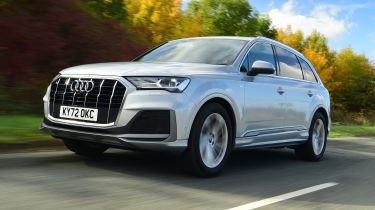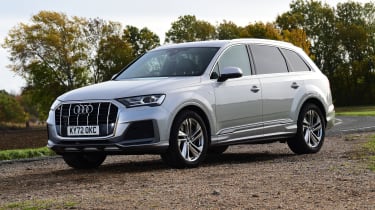Audi Q7 3.0 TDI: first drive in Namibian desert
Exclusive first drive of pre-production version of the new Audi Q7 in Namibia. It's set for showrooms this summer

In a world of car manufacturers, Audi included, that’s scrambling to build the next sub-division of the SUV market it’s refreshing to come across a car that does precisely what an SUV should. The Audi Q7 is big and useful, but refined and fun to drive at the same time. It’s not the last word in off-road ability, nor quite as dynamic as a BMW X5 - and the fussy styling won’t be to everyone’s taste, but it's a technical tour de force.
Reassuring, isn’t it, that while most Audi Q7s won’t see anything rougher than a speed bump on the school run, it’s tested to withstand some of the Earth’s harshest environments. From thirty below zero in the Arctic Circle to searing temperatures in the desert, the new Q7 needs to cope with them all.
As if to prove a point, Audi has brought us to the middle of the Namibian desert in southern Africa for a final sign-off drive in the all-new Q7 before it arrives in UK showrooms this summer.
The cars are pre-production models, but the fit and finish are already impeccable, and we’re putting them through their paces on 300 miles of gravel roads, winding mountain tracks and sand dunes. If it works here, we’re pretty sure it can handle your commute.
Used - available now
“There is a multiplication factor out here,” Dr Hackenberg, Audi’s head of technical development. “If it doesn’t squeak and rattle on surfaces like this, we know it’s going to be fine back on normal roads.”
This isn’t simply a re-skinned and re-trimmed version of the original model that launched nine years ago – it’s a rethink from the ground up. It’s the first VW Group product to use a new modular MLB-evo architecture designed for larger models with longitudinally-mounted engines. Eventually it will underpin the new Bentley Bentayga, replacements for the Porsche Cayenne and VW Touareg and every new front-engined Audi from the A4 upwards.
The benefits of the MLB platform are stark: the new Q7 weighs up to 325kg less than its predecessor thanks largely to a new steel and aluminium body (-71kg), redesigned multi-link front and rear suspension (-67kg) and all-aluminium doors (-24kg). Around 41 per cent of the Q7’s body structure is aluminium – not as much as the all-aluminium Range Rover (which shed 500kg compared to its predecessor), but then with prices starting from £50,340 the Q7 is an altogether more affordable car.
Choosing which one to go for couldn’t be easier, either. From launch, the only engine is a revamped 268bhp 3.0-litre six-cylinder diesel, connected to an eight-speed torque converter auto and available in SE or S line trim.
Even this more powerful diesel returns nearly 50mpg (a 26 per cent improvement), but a more economical 215bhp 3.0 TDI version will follow later in 2015, as will a diesel-electric plug-in Q7 e-tron producing a juicy 368bhp, but returning a claimed 166mpg and emitting 50g/km of CO2, Unfortunately, public charging points are a bit scarce around these parts, so we’re sticking to the 268bhp 3.0 TDI today.
Driving at 70mph on gravel is a unique experience – the loose stones mean the car’s constantly moving around underneath you.
What you need in these conditions is smooth, predictable steering, superb damping and plenty of sound deadening to keep the road roar out. Fortunately, those are three areas in which the new Q7 excels. Steel springs are fitted as standard, but our test car came with the optional adaptive air-suspension, whichdoes an incredible job of smothering the endlessly bumpy surface.
Dips and peaks that would have less well-controlled cars leaving the road, or bottoming out on their suspension, are dispatched with a pillowy softness in the Q7.
It’s quiet, too. At 70mph on gravel you can talk to passengers in the back without raising your voice – useful when the kids are playing up – suggesting that the Q7 will at least match the Range Rover for refinement on tarmac roads.
A new four-wheel steering system, also optional, can dial in up to five degrees of opposite turn at the rearat slow speeds to reduce the turning circle by a full metre. At higher speeds, they turn by two degrees with the front wheels to improve stability, and on loose surfaces that makes a difference.
When we do encounter a few twists and turns, the Q7’s new-found nimbleness is immediately apparent.As well as shedding 325kg, the centre of gravity is 50mm lower – demonstrated by the way it stays flat and, dare I say, feels adjustable in corners. OK, sliding around on gravel hardly represents real-world conditions, but the fact that we wanted to turn the traction control off and have a play speaks volumes.
With 600Nm at your disposal the diesel responds instantly, while the eight-speed auto delivers the torque to all four wheels in a seamless linear rush.
Given the conditions, grip is fairly unbreakable, too. In normal conditions the centre differential splits the torque 40/60 front/rear, but can send up to 85 per cent to the rear axle as required.
Although not destined for the UK, we tried a 3.0-litre supercharged petrol engine as well as the 3.0-litre TDI, and the difference in sound intrusion and smoothness is marginal. And as for weaknesses? Well, when the Q7 made its debut at January’s Detroit Motor Show, we weren’t bowled over by the styling, and it’s still not wholly convincing.
With all the bodywork now painted, it somehow seems lower to the ground, while the mass of lines around the wheelarches and shoulder line seem overly fussy. Still, there’s no denying it has presence, thanks largely to its enormous three-dimensional grille.
Open the door and there’s witchcraft going on inside. Despite being shorter, narrower and no taller than the old Q7, there’s more rear legroom and more headroom, too. All UK cars will be seven- seaters and thanks to a powered tailgate, plus a second row that folds and tips forward for easy access to the back seats, loading a five-a-side football team of kids, and all their kit, should be a breeze.
With seven on board there’s 295 litres of space, or 770 litres with the third row collapsed flush into the boot floor (done electrically with a button in the boot). With the second row folded forward, there’s 1,955 litres to play with. We climbed into the back, purely for research purposes, and can confirm that a five foot nine journalist can fit there, with the second row slid forward.
As for interior quality? Well, if this is a pre-production car, then the real thing should be typically magnificent. The 12.3-inch virtual cockpit is an option, but worth having, while the central pop-up screen is controlled via a huge touchpad and a more traditional wheel. Everywhere you look there are chunks of expensive-looking metal, supple leather and soft-touch materials on the dash – and we haven’t even got to the tech underneath.
A built-in 4G Wifi connection is available, but subject to a monthly subscription, while traffic jam assist accelerates, brakes and steers the car for you up to 37mph. There’s even a predictive efficiency system that reads road sign and nav data and warns you in advance if you need to slow down. Fortunately, none of these works in the Namibian desert, which let us appreciate, without distraction, what an amazingly accomplished car the new Q7 is.












